Art History Sum- Quiz 2
1/55
Earn XP
Name | Mastery | Learn | Test | Matching | Spaced |
|---|
No study sessions yet.
56 Terms
[R]ealism
This new artistic movement addresses the plight of the working class through the work of its artists. The art of this movement addresses political change and asks whether there is a new political or social audience for art.
[r]ealism
refers to the broader technique or approach in art that strives for lifelike, accurate representation of subjects
Academicism
An artistic movement characterized by a strict adherence to traditional forms, techniques, and rules in art.
Orientalism
False/fictional view of Asia (the middle east) created for and by westerners/ inherently political/ east is portrayed feminine, irrational, and weaker/ "the other" is different from "the us”
Popular Culture
Refers to mainstream trends and practices within a society that are embraced by the general public. It includes aspects such as music, fashion, news, etc.
Avante-Garde
Strikingly “new” Innovative and experimental in style or technique, often challenging traditional norms and pushing boundaries in art, culture, or society. Derived from the french word ‘before the group’ or ‘vanguard’
Impressionism
Art movement in late 19th century. Emphasizes capturing momentary impressions of light, color, and atmosphere. Artists include Monet, Renoir, and Degas.
Impasto
Impasto is a painting technique where paint is applied thickly to create texture and depth, often using a palette knife or brush.
Japonisme
Artistic movement in late 19th century France influenced by Japanese art and culture, characterized by flat patterns, asymmetry, and nature motifs.
Flaneur
A French term for a leisurely urban stroller or observer, typically associated with rich white men who don’t work for a living
Modernity
the cultural and artistic movement characterized by a break with traditional forms and an embrace of new techniques, perspectives, and themes
Impressionism: Emphasis on light, color, and everyday scenes, often capturing fleeting moments.
Cubism: Fragmentation of objects into geometric shapes and multiple perspectives.
Surrealism: Exploration of the unconscious mind and dream-like imagery.
Expressionism: Intense, emotional depictions often using bold colors and exaggerated forms.
Haussmanization
Urban planning strategy implemented by Georges-Eugène Haussmann in 19th-century Paris, involving wide boulevards and modernization of infrastructure.
Plein air painting
Artistic technique of painting outdoors to capture natural light and landscapes. Popularized by Impressionist artists in the 19th century.
Post-Impressionism
Art movement following Impressionism, characterized by artists like Van Gogh and Cézanne. Emphasizes symbolic and abstract elements over realistic representation.
Divisionism
Art movement characterized by using small distinct dots of pure color that are optically blended by the viewer's eye to create a harmonious and vibrant image.
Primitivism
Art movement emphasizing simplicity, raw forms, and cultural authenticity. Often inspired by non-Western art and seeks to evoke a primal, instinctual response.
Analytic Cubism
First form of cubism, less saturated colors (drained), almost monochrome/earth-toned, grid-like lines, a distorted sense of space that creates a sense of flatness, unusual modeling used illogically, “painting about painting”, makes us aware of the canvas itself
Collage
Art technique using various materials like paper, fabric, and photographs to create a composition. Developed by Picasso and Braque in the early 20th century.
Assemblage
Art technique using found objects to create a 3D collage. Popular in modern art, it involves arranging and combining various materials into a cohesive composition.
Synthetic Cubism
Major re-introduction to color, curvalinear forms/textures, moving away from physical collage to a collage effect via oil painting.
Fauvism
Occurring at the same time as cubism, “fauves”= wild beasts, characterized by saturated/vibrant colors and non-local application directly from the tube, fierce brush work/daubs of paint and simplified forms.
Non-Objective Abstraction
No recognizable subject matter/ shapes and colors
Expressive Abstraction
Expression of emotional/ spiritual themes, collapsing academic boundaries.
De Stijl- “The Style”
an artistic movement founded in the Netherlands. It aimed to create a universal aesthetic by focusing on simplicity and abstraction. Emphasis on straight lines, geometric forms, and primary colors (red, blue, yellow) along with black, white, and gray. Use of asymmetry and the reduction of elements to their essential forms and colors. Influenced architecture too.
Der Blaue Reiter (The Blue Rider)
an influential group of artists within the German Expressionist movement, founded in Munich. The name is derived from a painting by Wassily Kandinsky, a founding member
The Armory Show
Traveled throughout US from New York, US introduction to European modernism featuring Picasso, Dechamp, Matisse, van Gogh, figuring geometricized forms, fleeting moments, personal expression non-local color. Inspired American artists to incorporate in their art.
Harlem Renaissance
an intellectual, social, and artistic explosion centered in Harlem, New York. It was a cultural movement that celebrated African American cultural expressions and challenged racial stereotypes. Flourishing of African American literature, music (especially jazz and blues), theater, and visual arts.
Great Migration
the mass movement African Americans from the rural Southern United States to urban areas in the North. Escaping racial segregation and violence in the South/ Seeking better economic opportunities and living conditions in Northern and Western cities.
Pan-Africanism
a political and cultural movement that seeks to unify African people, both on the continent and in the diaspora, to promote solidarity, economic development, and the eradication of colonialism and racism.
Re-appropriation
The process by which a marginalized or oppressed group reclaims terms, symbols, or cultural practices that were previously used in a derogatory manner against them, transforming them into positive expressions of identity and empowerment.
Gustave Courbet: The Stone Breakers
Showing the labor of breaking large rocks down to gravel for pavement. Youthful boy & older man showing you are born and die into poverty. Boy is straining to hold heavy rocks, man kneels on hay in the act of swinging axe- showing their active labor. Clothes in state of distress, patched pants only one suspender, holes in shirt. Courbet sees this as a social injustice. Faces are turned to show their individuality isn’t the focal point, rather their labor is. Desaturated earth-toned palette, to show the lifeless heat. Pot w/ spoon to show they’re working for a long time. Rejects academy techniques, thick impasto w/ palette knife, matte finish, wants to elevate laborers to history painting, not glorifying their presence but showing the harsh reality of their situation (political agenda). Known as “The first socialist painting” destroyed during the war.

Jean Francois Millet: The Gleaners
Backbreaking work to collect the scraps from harvest, considered charity by wealthy farmers because by cleaning the field scraps they can eat for free but end up helping the farmers. Smaller in scale.
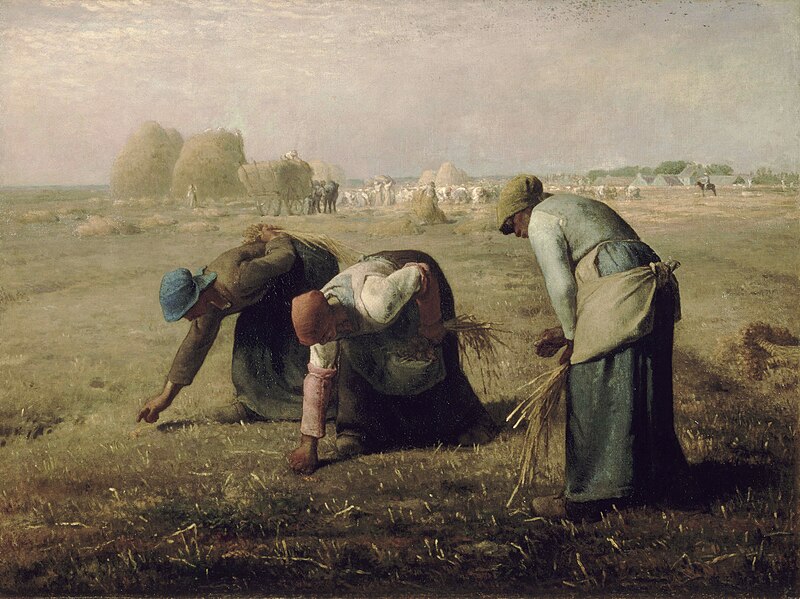
Eastman Johnson: A Ride for Liberty- The Fugitive Slaves
Foggy terrain, figures are shadowed, father protects boy who is bracing against the speed, horse’s legs are blurred (going fast AF), mother looks behind clutching baby.
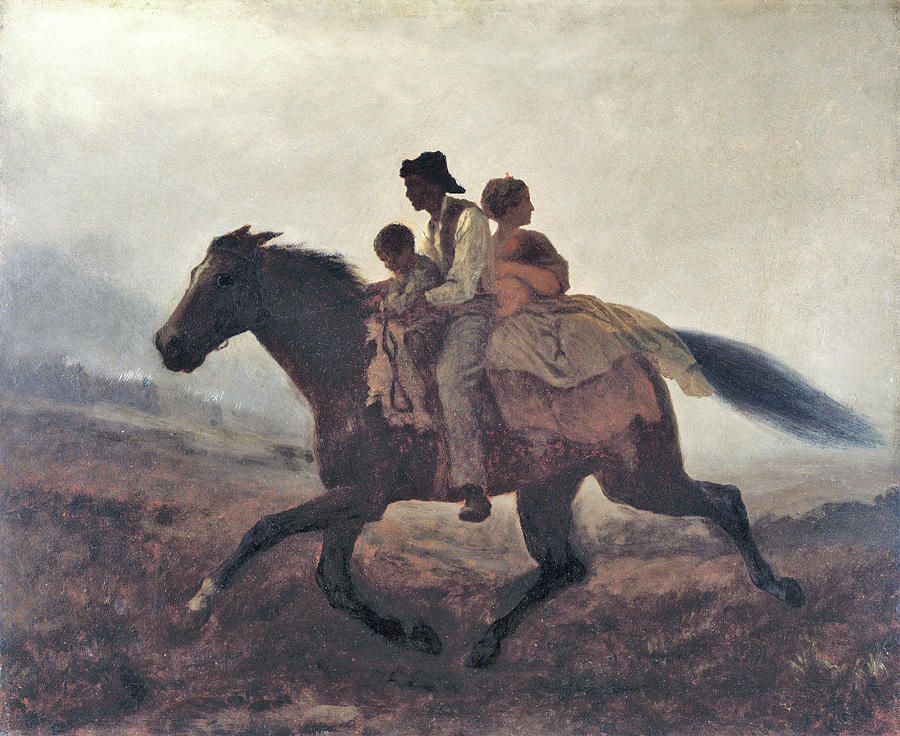
Edmonia Lewis: Forever Free
Emancipation proclamation, abolitionists work, a sculpture of a couple, depicting the right to marry (once forbidden to slaves, now emancipated), stands on the chain that once bound him, holding the girl protectively while hand in the air triumphantly, made in Rome shipped to America to pay off loan for marble.
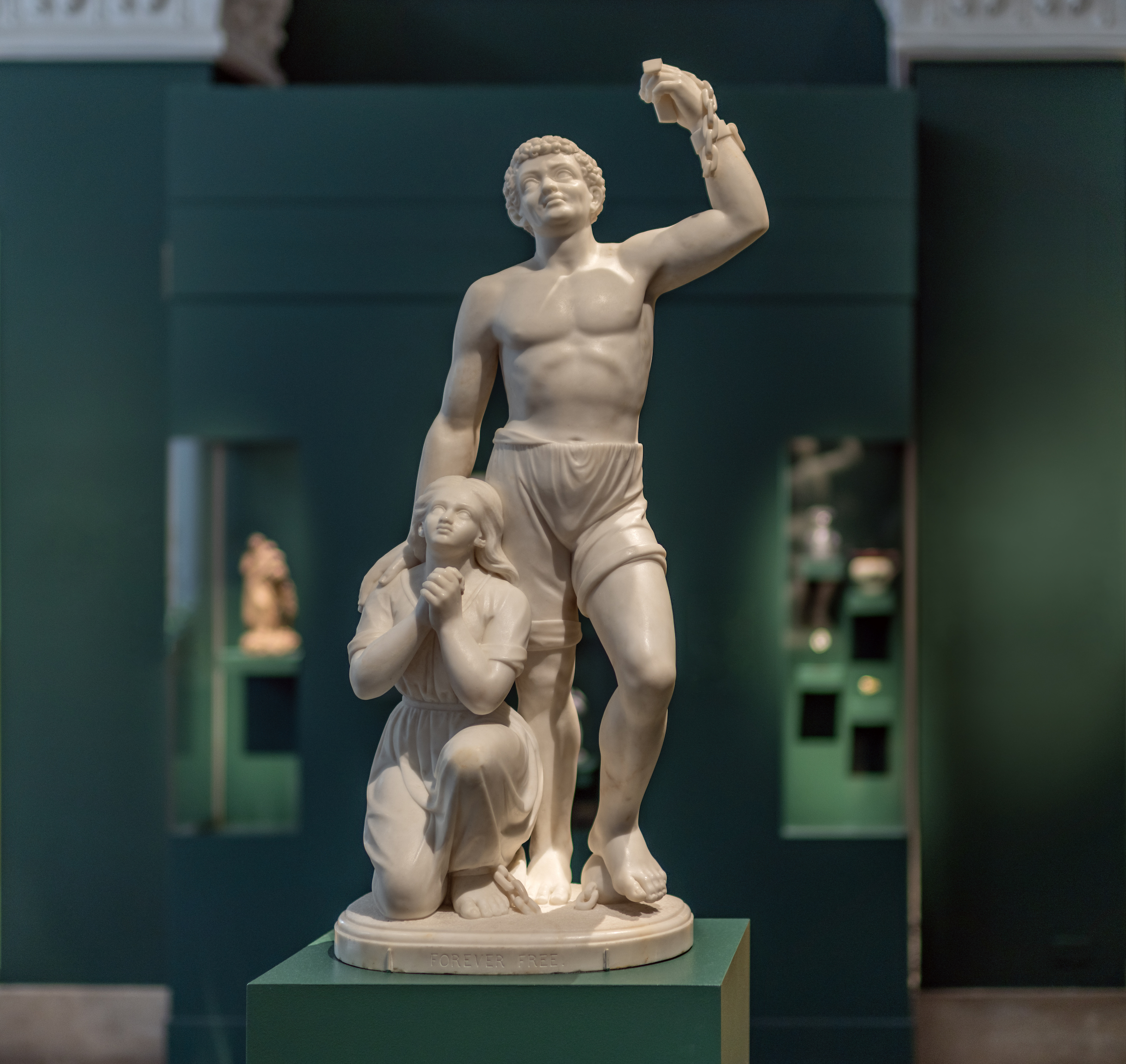
Henry Ossawa Tanner: The Banjo Lesson
Grandfather and grandson bonding with music, humble, but not impoverished home, domestic space, pictures on the wall, wooden floor, loving well off home, painting African-Americans as people living their lives.

Edouard Manet: Olympia
Black servant, bringing cortesean flowers, read the figure as a sex worker, Manet’s favorite model used (street singer), gaze confronts the viewer, viewers occupied the role of her clientele, pose modeled after Titian’s Venus of Urbino. Manet has a very flattened. Space, colder/dark color, palette, visible brush work. Pose and gazes presented different. Titian is coy/ sensual/ relaxing/ inviting versus Manet’s is confrontational/ forcibly blocking/ easy. Titans has symbols of marriage/fidelity/fertility Manet has spooked black cat (unwelcoming/opposite of Fidelity) large bouquet=gift, luxury pashmina, noticeably naked (clothes around her) Olympia seems bored. Rejecting and critiquing academic tradition of the female nude.
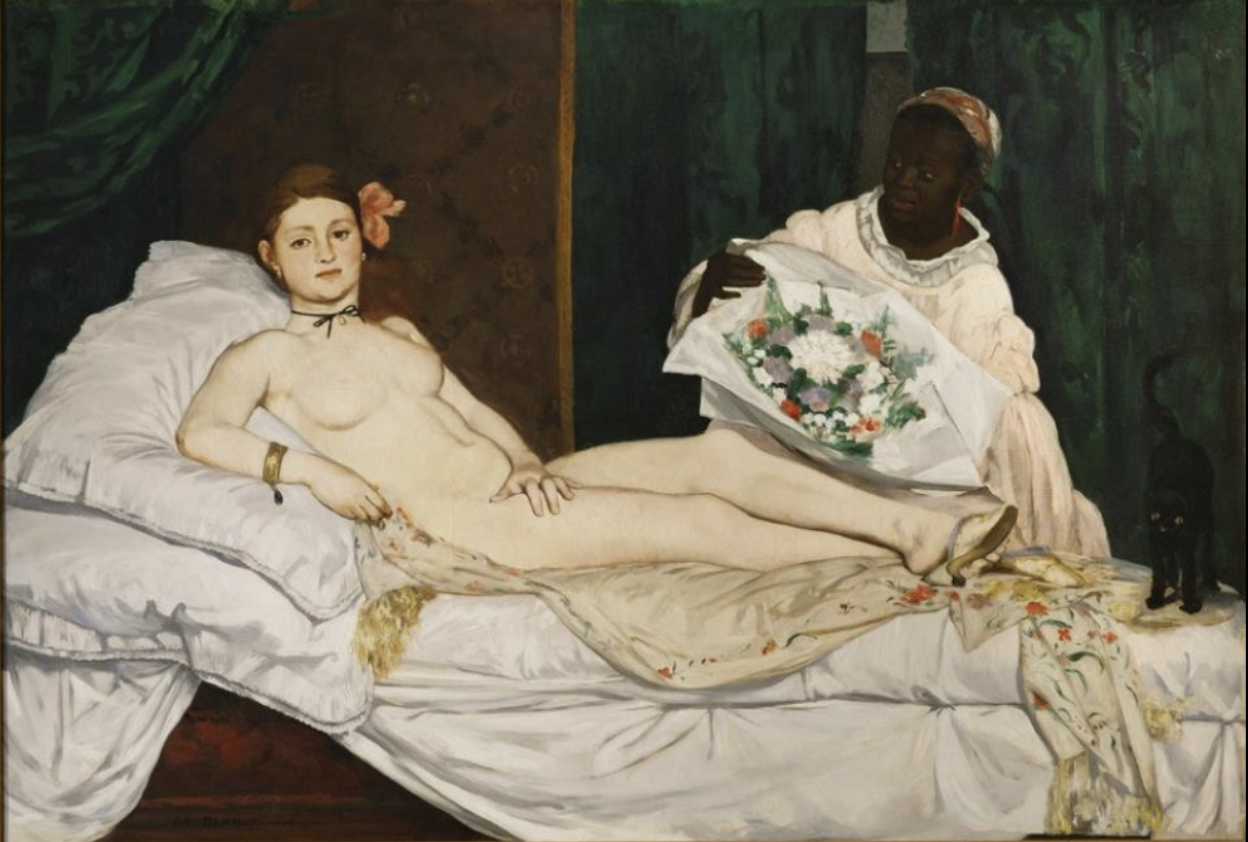
Claude Monet: The Gare Saint Lazare- Arrival of a Train
Worker in foreground, back to us, curvalinear brushwork to show smog, metal structure still visible, Monet lied to train conductors to get them to produce more smoke by claiming to be a celebrated Salon painter.
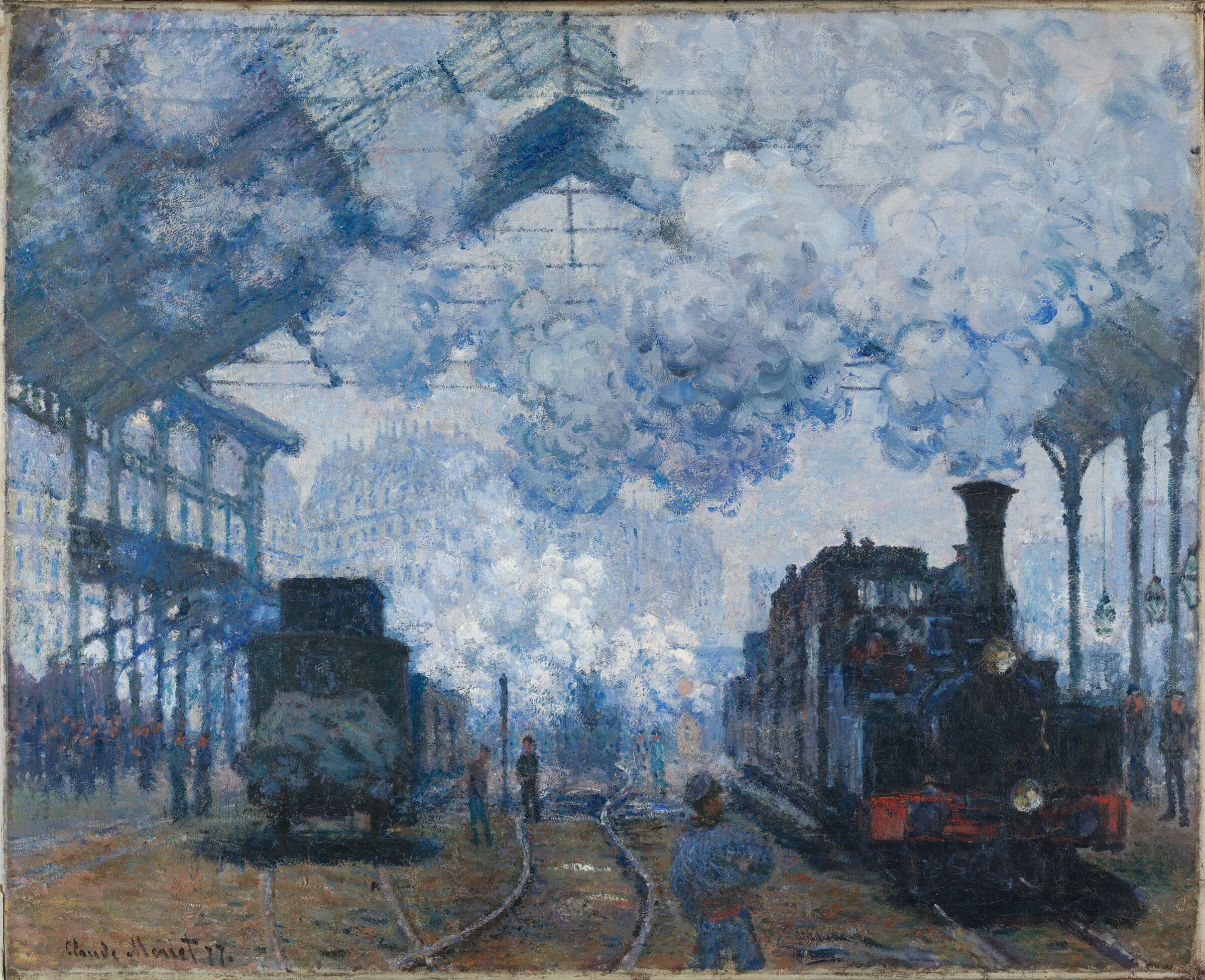
Berthe Morisot: Young Woman Powdering her Face
Making a comparison putting makeup to face= paint to canvas, we’re occupying her personal space, the mirror is not for us, we can’t see the reflection (compared to use of mirrors prior), spatially arranged to show intimacy
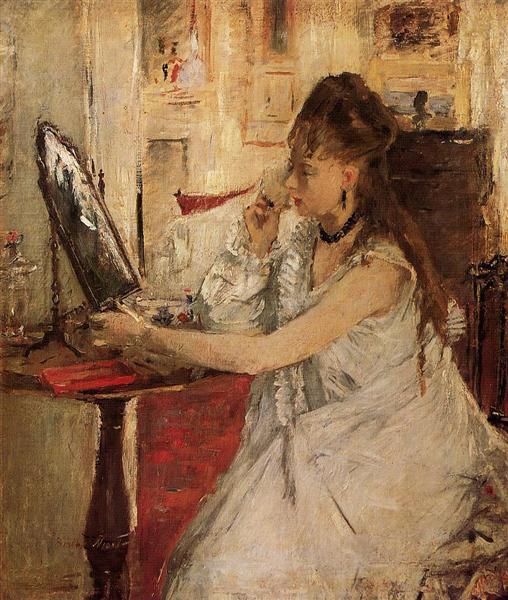
Mary Cassatt: Little Girl in a Blue Armchair
A young girl lounging in a large, blue armchair with a dog resting nearby. The girl appears relaxed and absorbed in her own world. Asymmetrical arrangement with a focus on the large blue armchair dominating the scene, giving a sense of casual domesticity. Dominated by cool blues and greens, with contrasting warm tones in the girl's clothing and the dog's fur. Impressionist influence with loose brushwork and an emphasis on capturing the moment's atmosphere and the play of light.
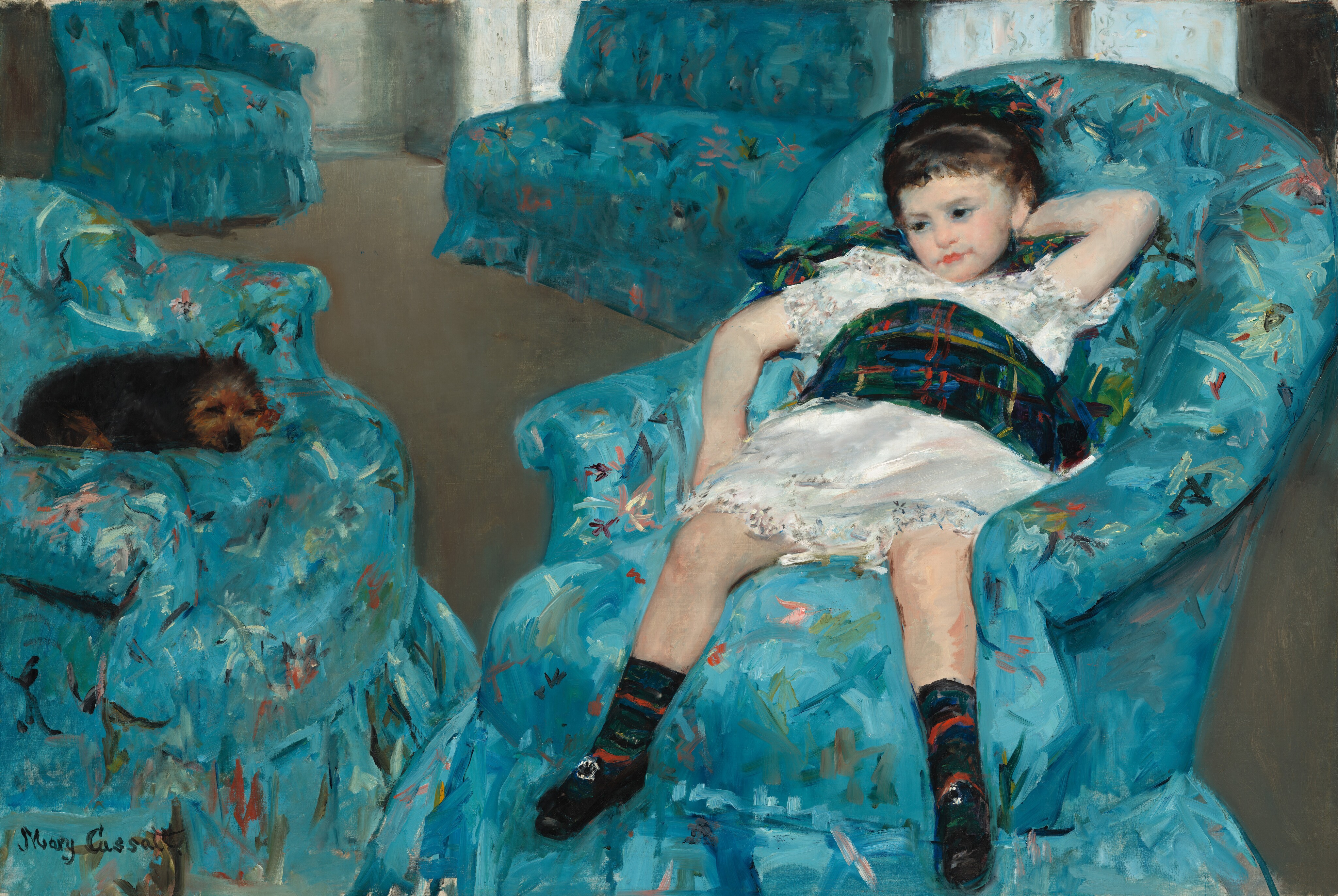
Georges Seurat: A Sunday Afternoon on the Island of La Grande Jatte
Most famous work, class dynamic: multiple social types, top hat man w/ courtesan & pet monkey (sign of lust), working class oarsman, mother and child promenading, stiff formality to figures (classicism), pointilism, unblended colors, structuring/ ordering painting, crisscross technique, none of the figures actually interact, comparing artist to laborer, alienation/ isolation
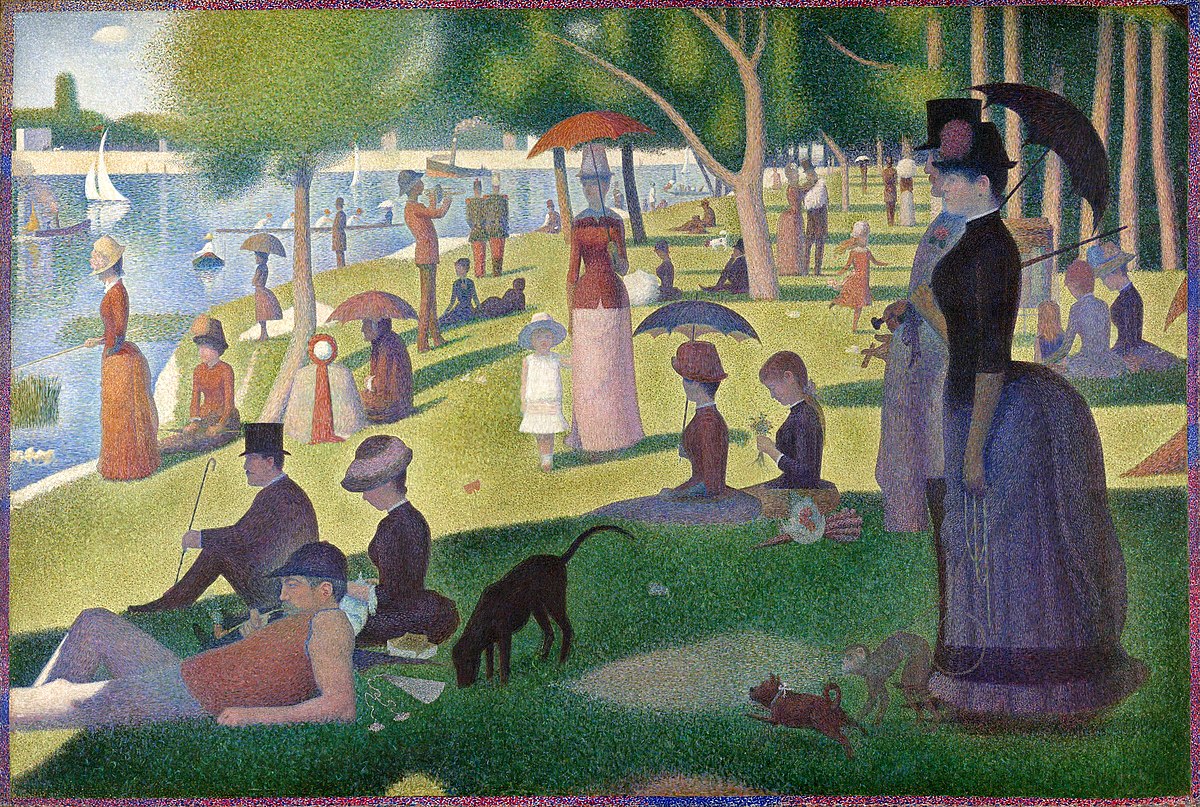
Henri de Toulouse- Lautrec: Moulin Rouge- La Goulue
Artists increasingly rejecting salon rules, aristocratic “outcast” equates himself to working class, radical politics, subject matter works across mediums: lithographs and prints, thinking about art in different ways. Advertisement for Moulin Rouge popular venue, large scale, graphic print across three pages to attract clientele. This poster made an overnight sensation grab passerbys attention )(not in a gallery) on the street. Pallete= yellow, black and red. Crowd of onlookers show popularity. Silhouetted figures. Midground=“The glutton” performs the “can-can” flashing bloomers to the crowd, alluding to kicking top hat off partner (superimposed style). (first person to identify represent a performer stylistically). Distilled down to key forms. Dance partner= silhouetted w/ top hat, simplified to identifying features exaggerated. Abstract, yellow orbs= stylized representation of lighting of Moulin Rouge. Top hat’s thumb alludes to sexual suggestions (can-can= suggestive).

Vincent Van Gogh: The Artist’s Bedroom in Arles
Flatness inspired by Japanese prints / Odd proportions of beds / Special distortion / Balance through complementary colors. Purple walls with yellow bed frame. / Furniture functions as a stand in for the less luxurious art style. Humbly crafted objects. / This is his perspective rather than an accurate depiction of space.
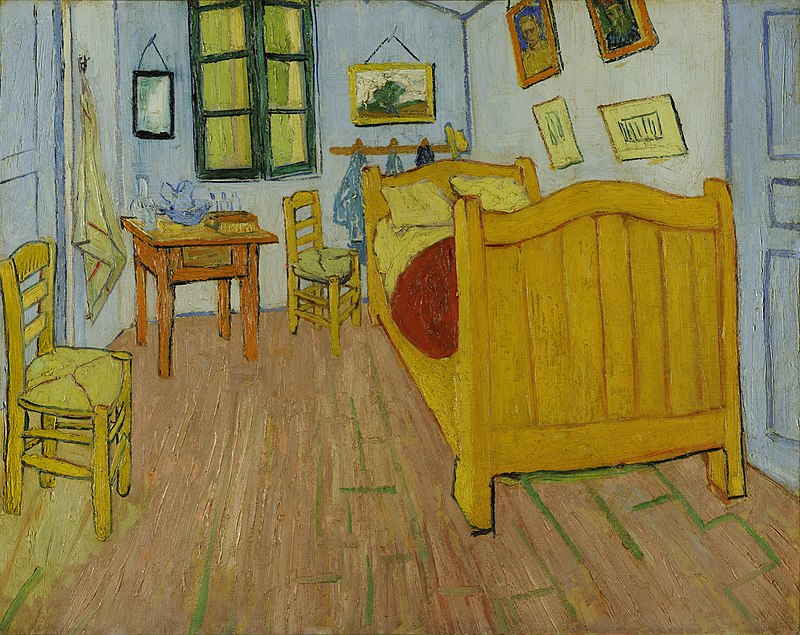
Paul Gauguin: Vision of the Sermon (Jacob Wrestling the Angel)
Galic and French tradition blend Supposedly an untouched part of town. Scene from Gaugin’s imagination Style heavily influenced by Japanese art. Notably departs from impressionism. Big flat parts of nonlocal color (flat red instead of grass) Heavy contour lines.
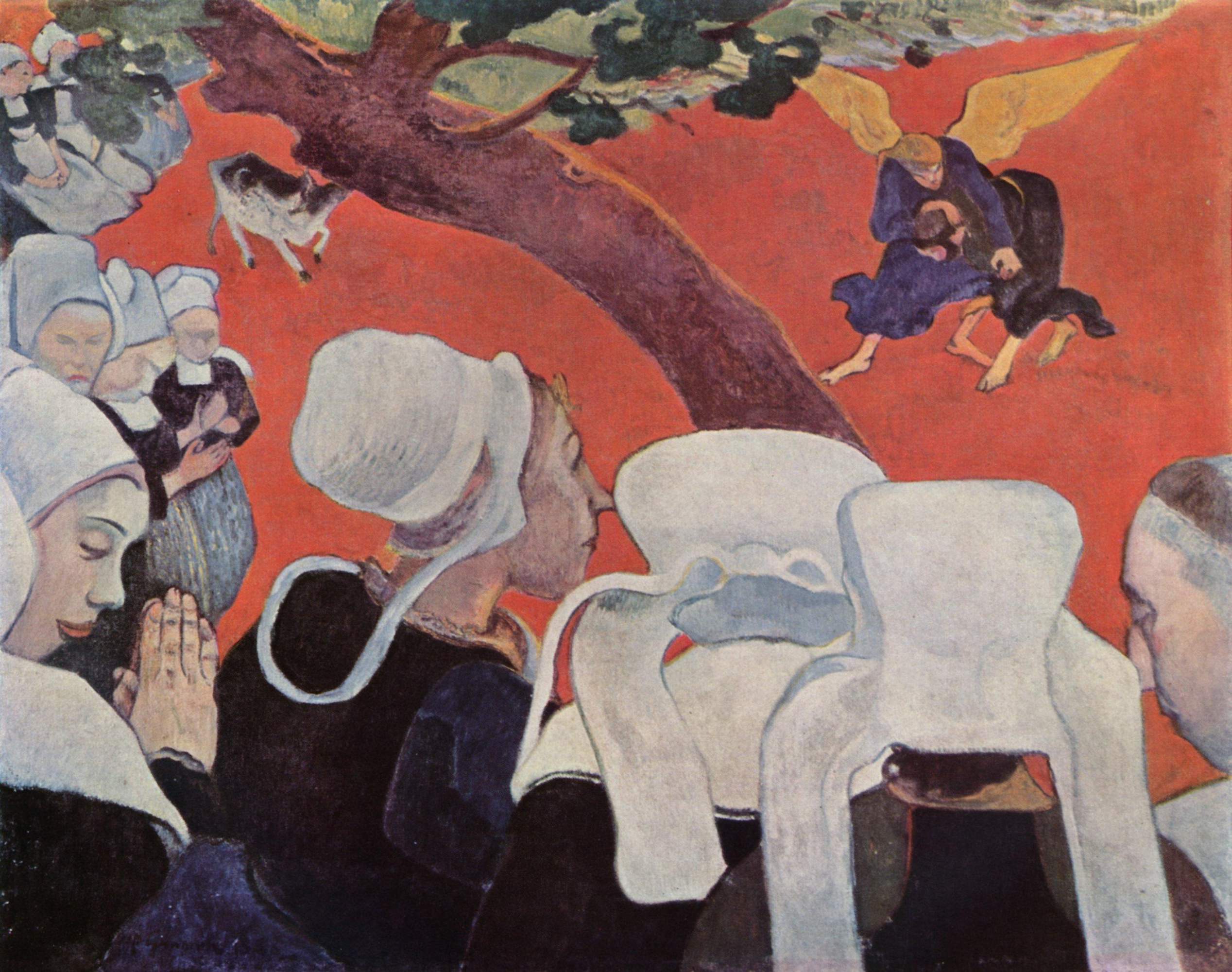
Paul Gauguin: Ia Orana Maria (Hail Mary)
Utopian vision that nonwestern cultures are simpler and that he would prefer that lifestyle. Combines completely unrelated cultures to create the image. Primitivism: Problematic borrowing of subject matter or forms from prehistoric sources or nonwestern cultures. Appropriate of culture to refresh western art.

Paul Cezanne: Mont Sainte-Victoire
He has returned to this composition multiple times Limited or reduced color palette. Strokes become more homogeneous. Pioneered the Passage Method: Creations of small intersection strokes Flattens the 3d Space drawing attention to the materials. The world of painting is detached from the world Landscapes become another world because of abstraction.
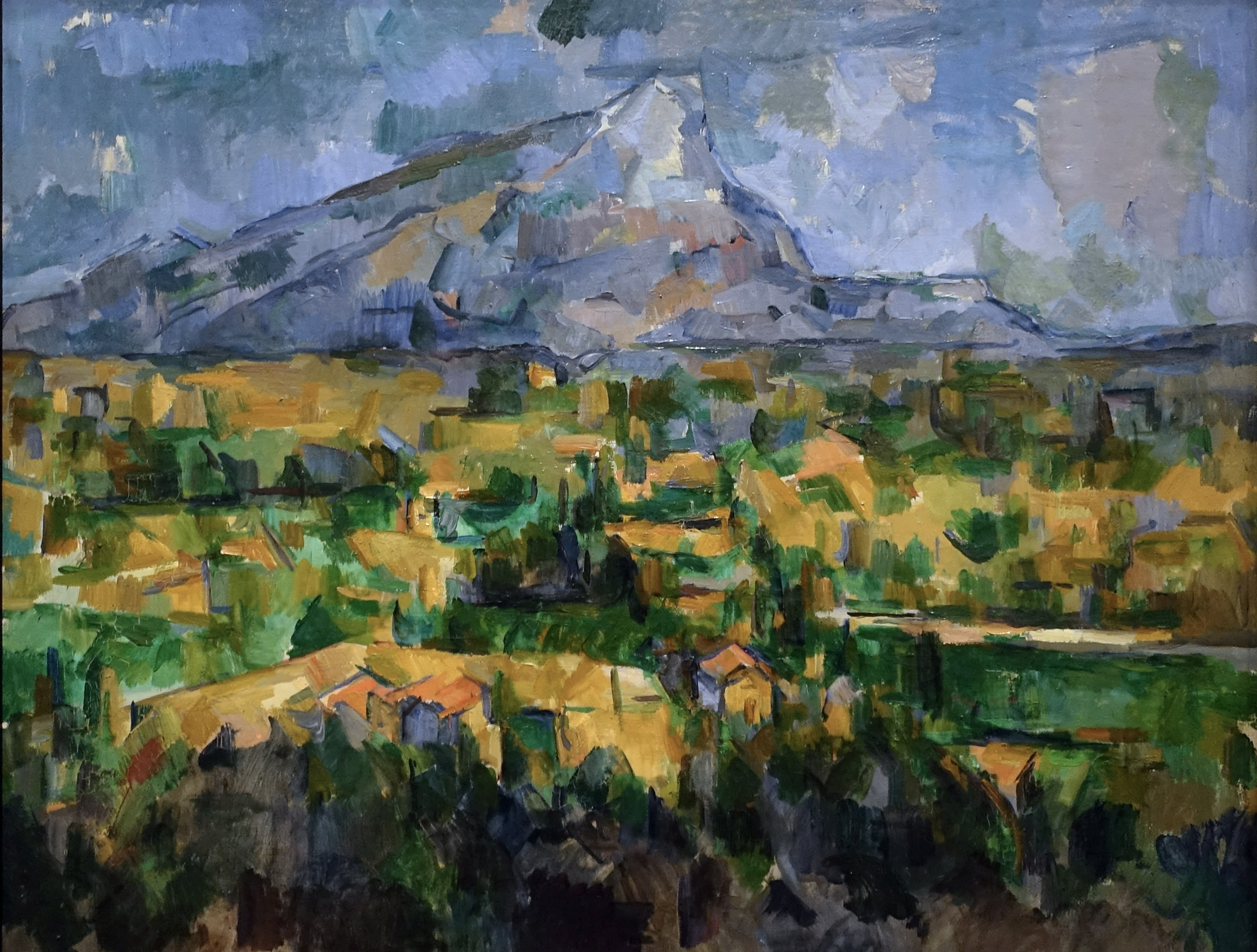
Pablo Picasso: Les Demoiselles d’Avignon
Radical representation of female nude. 5 sex workers (due to pun in name). Greater emphasis on lines and form. Preliminary sketches show it was meant to be a narrative scene. Medical student and sailor. Memento Mori of the skull was to warn the sailor he would get an STD. Removes the warning of going to brothels placing the viewer as the patron. Hard to locate where the women are in space. Still life in foreground with phallic imagery. Women are flat and geometricized with thick contour lines and sharp angles for their bodies. Exaggerated modeling which doesn’t give them a sense of three dimensionality. The women are meant to appear grotesque and shocking. Aggressive attack on the female nude. People aren’t finding this sexy. This reveals Picasso’s misogyny. Primitivism Faces inspired by Iberian relief sculptures and African masks Cultural and artistic appropriation. 3 forms of shock Stylistic disfunction Special disfunction producing ambiguity Psychological confrontation of differences (sexual, racial and class)
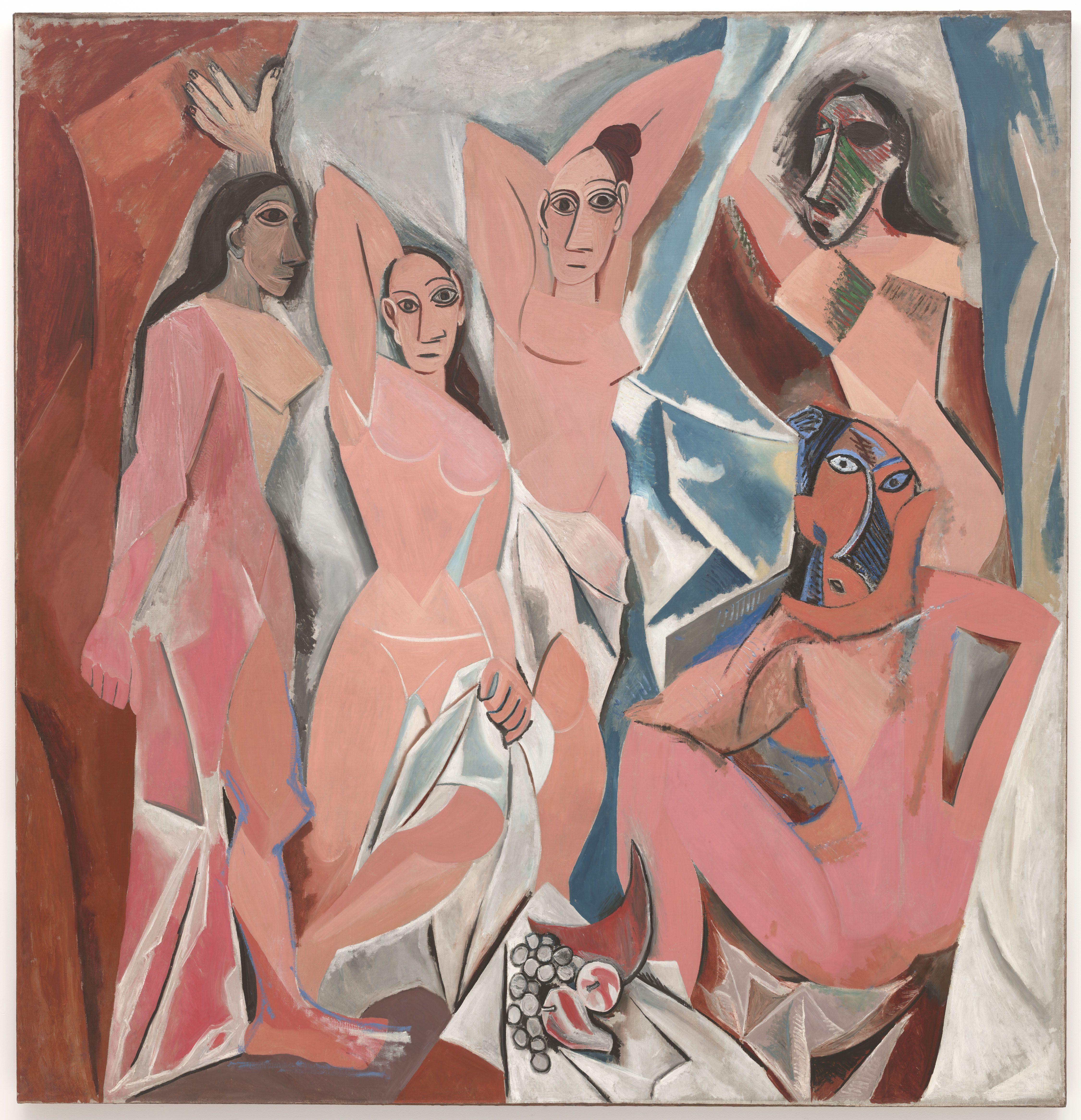
Pablo Picasso: Still Life with Chair Caning
Collage w/ low brow material. Elevation of lowly everyday materials like wallpaper and sheet music. Break from Analytic Cubism. Real rope as frame, “woven chair caning” (commercially made) vinyl. Window unto another world. Table top-down perspective, Jou = Journal (newspaper)/ Jouer (to play). Trompe l’oeil (trick the eye), analytic cubism at top. Lemon wedge (fruity beverage), wine glass casting shadow, cigarette with smoke. Viewers aware of realism but refuting expectations.
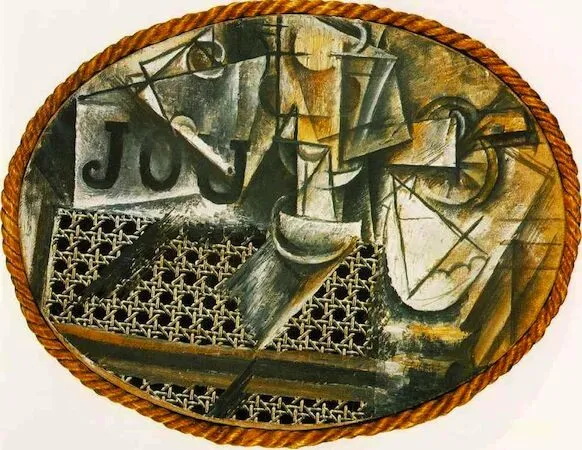
Henri Matisse: Woman with Hat
Not traditional portraiture, using color to capture his own emotions, general color palette then works the canvas up for various saturations, no black contour lines, heavier impasto in certain areas for selective emphasis.
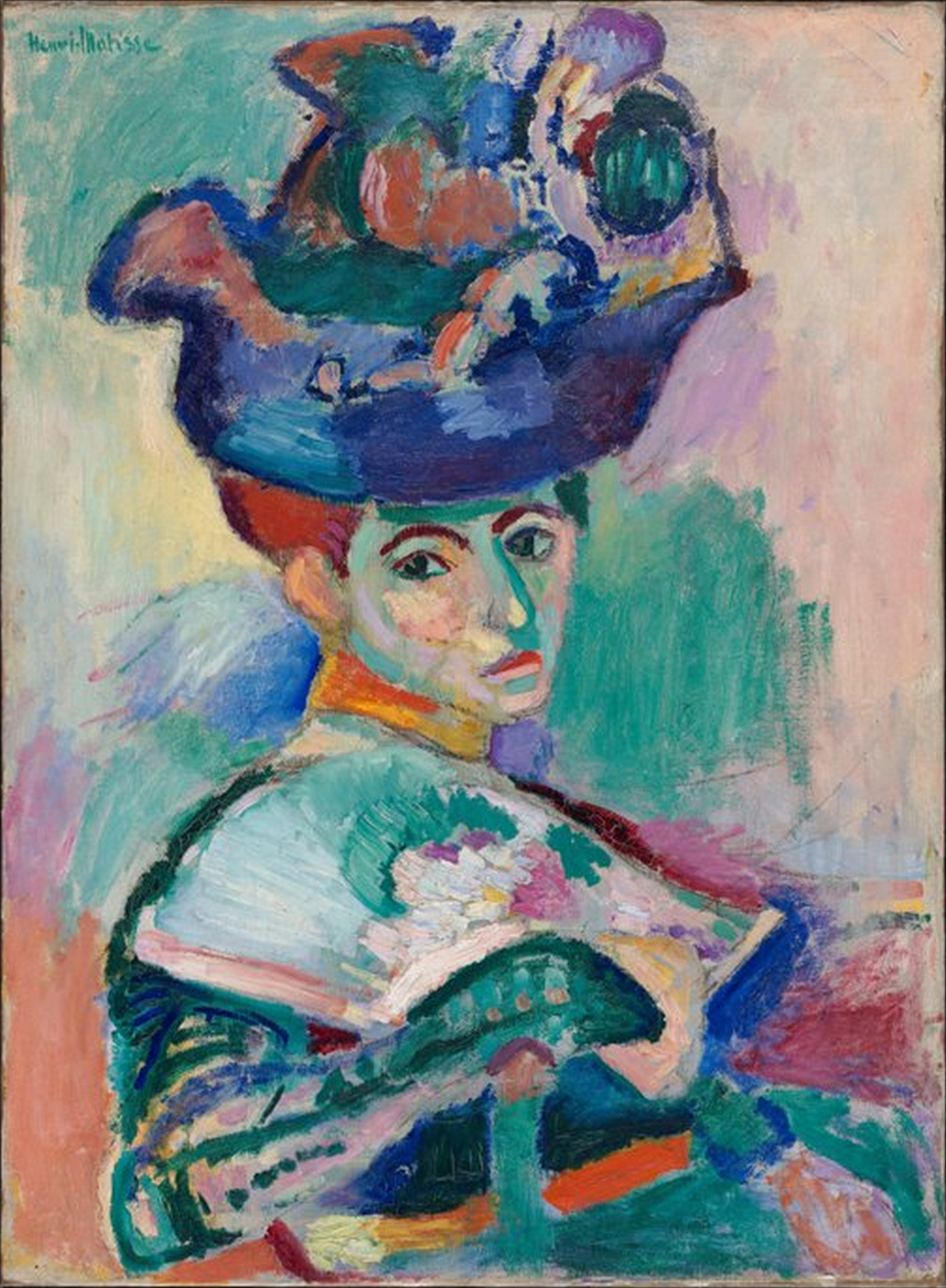
Henri Matisse: The Joy of Life (La Boneheur de vivre)
Large scale work shown @ salon, most famous work, loss of naturalistic color, curvilinear contour lines of figures & trees, moves viewers eyes continually and infinity, aimless sightmap different from previous works with intent where to look. Pastoral/ reclining nude. Arcadian associations. Citing shape and groups of figures from Dominique Ingress, The Golden Age. Tension between figures individuality. Illogical shifts in scale. Some figures are more anatomically correct than others. Attack on female bather tropes, commentary on art. Dancing nudes refer back to 3 graces- Botecelli. Play on gender difference, flute player= only clear male (anatomically), sexual anatomy de-emphasized, androgynous & merged figured melding. Abandoned neo-impressionism, studio construction (not Plein air), psychedelic color.
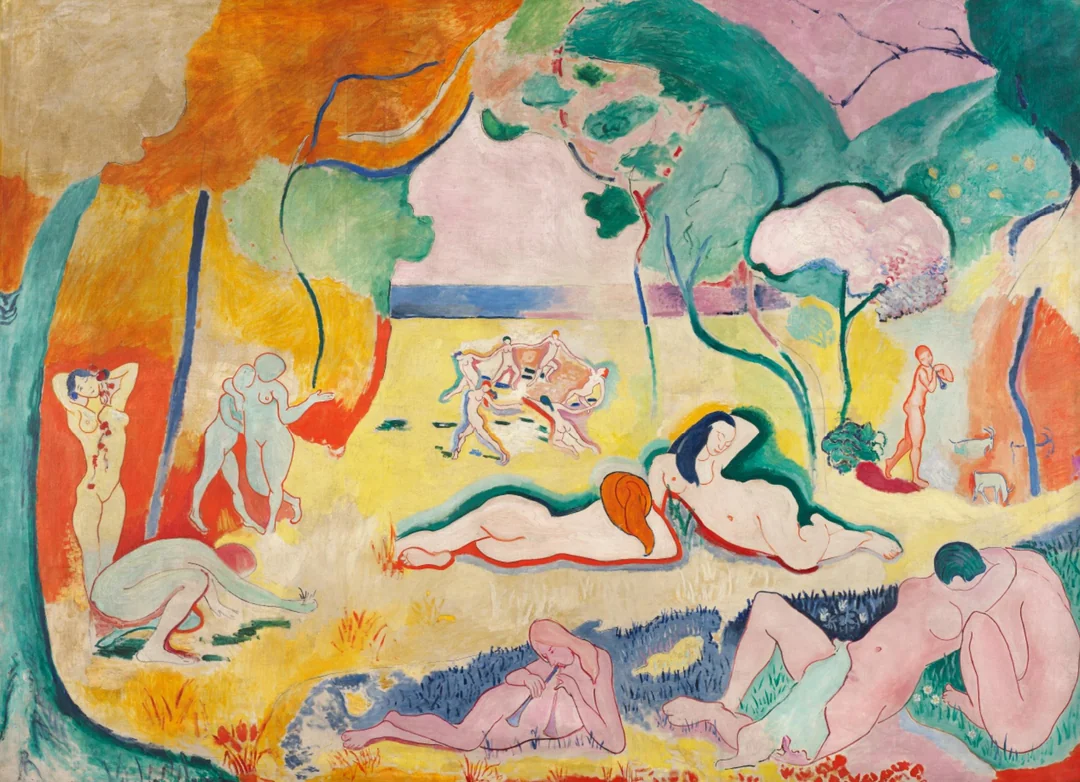
Piet Mondrian: Composition with Large Blue Plane, Red, Black, Yellow and Gray
Geometric abstraction, color= primary/ lines= b&w. Mondrian plays with distinction color/ ground, line/ form. Lines stop suddenly: creates space (expectation), strategically placing color to balance it out. Painting flat by hand (nuances).

Wassily Kandinsky: Composition V
Same year as Kandinsky’s memoir, heavily influenced by music, especially Wagner, translating composers into forms that move/ weld into eachother like music, art (even without concrete imagery). Synesthesia- hear color and see music. Anti-formalist, goal to use abstraction to crete an experience for viewers. Curvilinear lines.
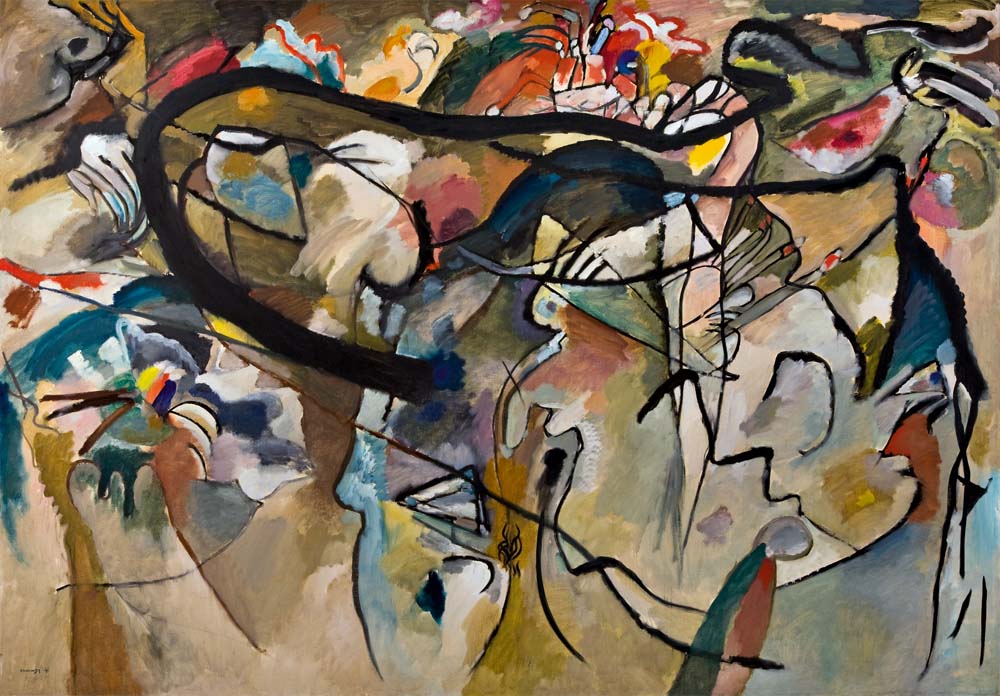
Georgia O’Keefe: Red Canna
Pure abstraction, usually to record her feelings. Often unwelcomingly misinterpreted as a gender/ sexuality narrative. Following this piece, turned away from abstraction to representational, and back toward her late late life.
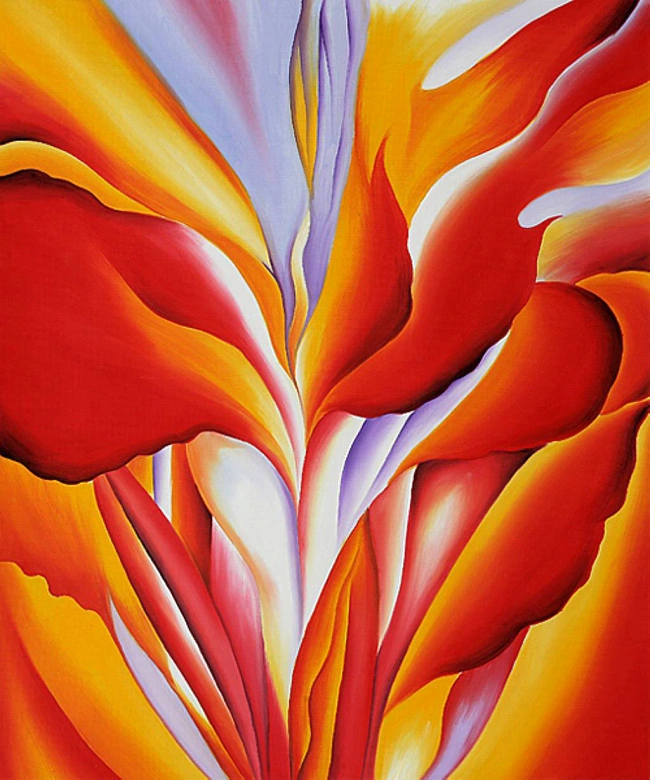
Lois Mailou Jones: The Ascent of Ethiopia
Egyptian/ Ethiopian headress, ascent to Harlem, reference to Polaris (important to the underground railroad). Words: Music, Drama, Art in background to show the flourishing of arts in Harlem.
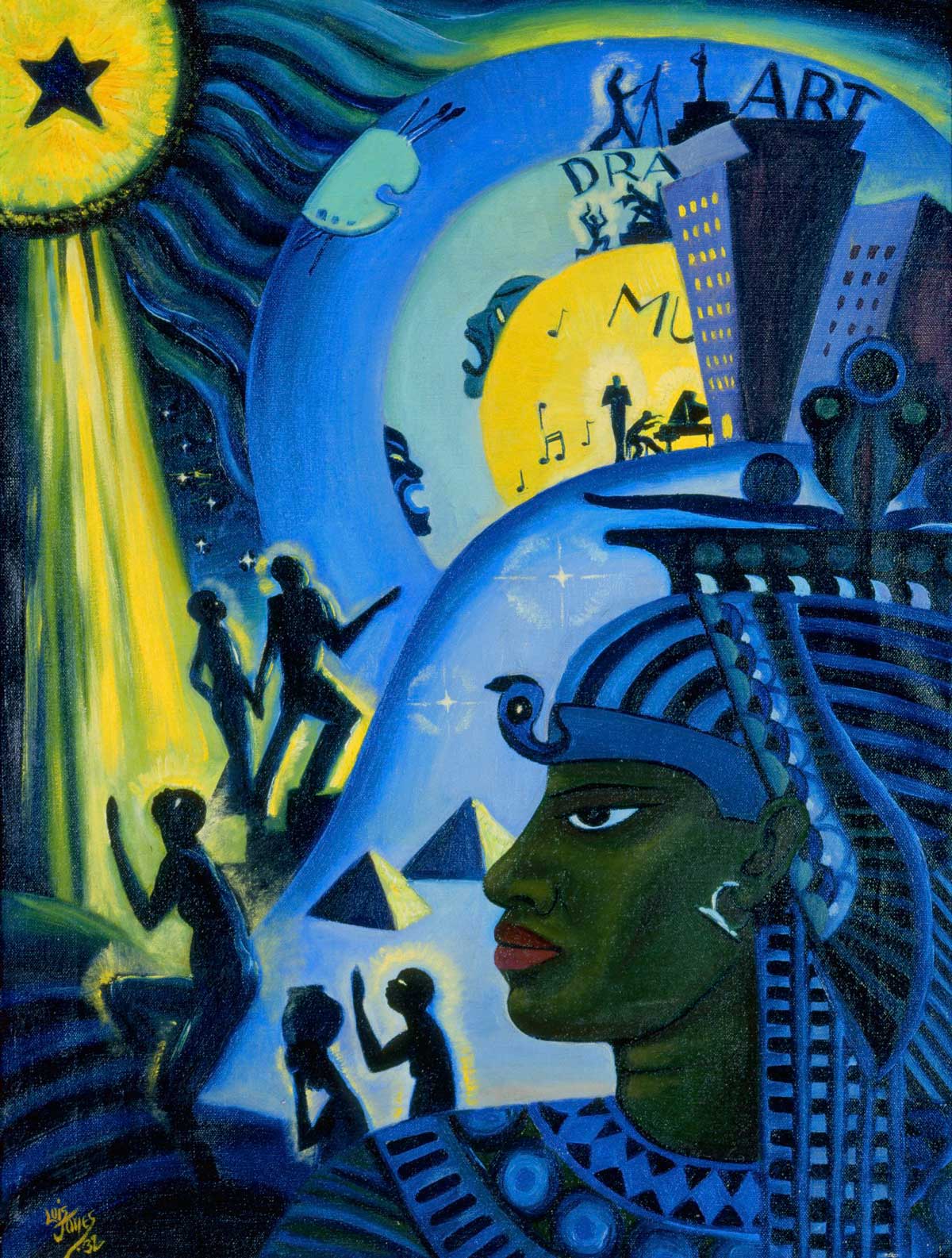
Malvin Gray Johnson: Postman
Uniform emphasizes his respectable position as a postman. Agency, looking at us, self-assured eye contact. Confident pose, fully frontal and nonchalante. Books= well read. Similar to Van Gogh’s Postman.
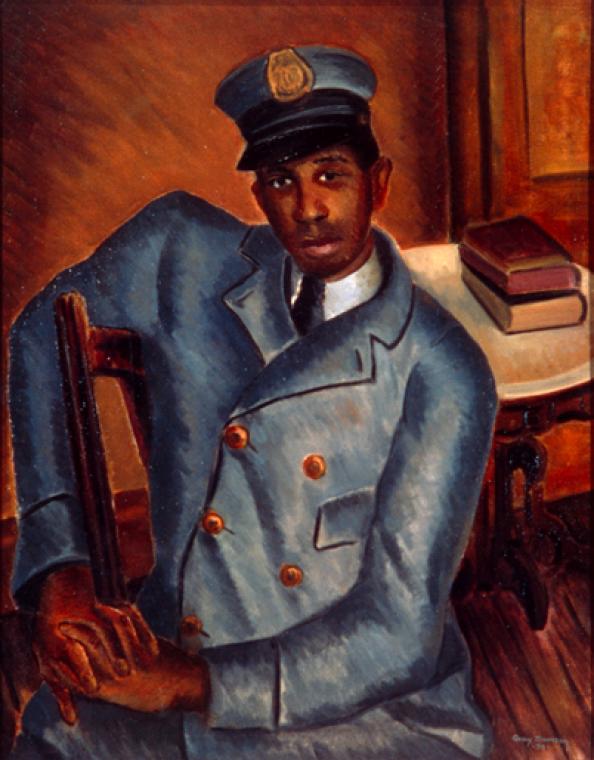
Jame VanDerZee: A Member of Garvey’s African Legion with his Family
photography of people of color, removing ethnographic lens, sitters shown at their best, respectable, powerful.
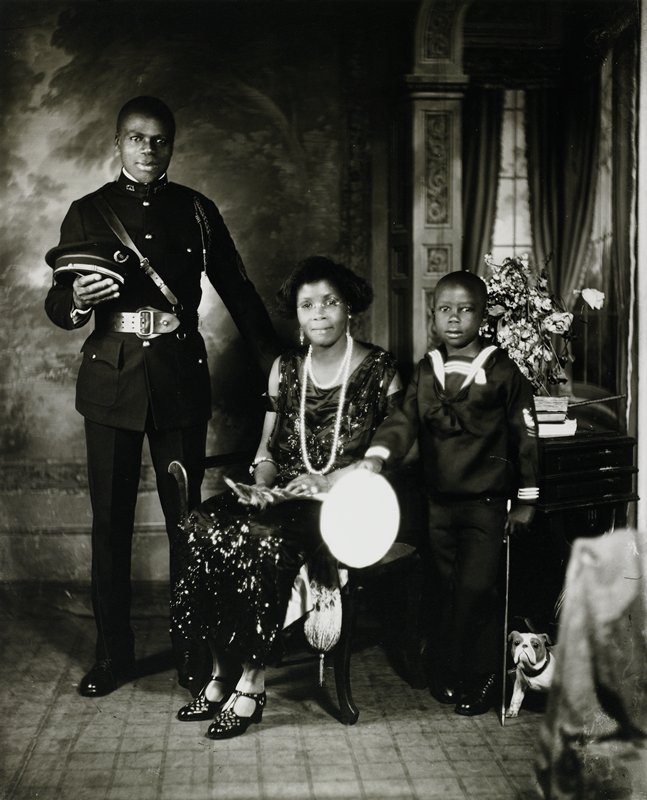
Jacob Lawrence: The Migration Series
sixty panels divided into 8 sections: Causes, Stimulation, Spread, Efforts to check, Public Opinion, Effects on the South, Effects on the North, Effects on the Negro. Fellowship to study at NYC Library. Piece= Historical remembrance, to tell the history of ordinary people and skew viewpoints. Shared limited color palette across the panels. Small panels, organized a multitude of ways. Launches Lawrence’s career, 26 panels published in 1941 issue of Fortune, which ultimately spread his work to a wider audience. [R]ealist: peaceful protest (like Courbet in his time).
![<p>sixty panels divided into 8 sections: Causes, Stimulation, Spread, Efforts to check, Public Opinion, Effects on the South, Effects on the North, Effects on the Negro. Fellowship to study at NYC Library. Piece= Historical remembrance, to tell the history of ordinary people and skew viewpoints. Shared limited color palette across the panels. Small panels, organized a multitude of ways. Launches Lawrence’s career, 26 panels published in 1941 issue of Fortune, which ultimately spread his work to a wider audience. [R]ealist: peaceful protest (like Courbet in his time). </p>](https://knowt-user-attachments.s3.amazonaws.com/f1254ddf-520c-41f3-b51b-69744cc5c8ce.webp)